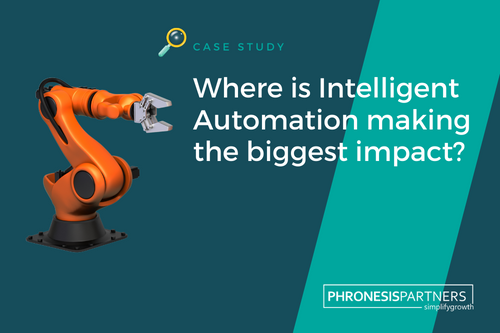A Fortune 500 tech company’s AI solutions landing page was underperforming with low click-through rates and sales inquiries. The company needed to update its online messaging to drive engagement and increase sales inquiries by gaining a better understanding of its prospects.
Overview
The company believed that the existing content lacked clarity and as a result was not generating enough curiosity or interest around their services.
They asked Phronesis Partners to undertake research of their target clients to understand why this was happening and whether presenting their AI Solutions differently would improve results.
Our Approach
Exploratory Phase
Phronesis Partners’ review of the client’s website presentation of its AI Solutions highlighted concerns that instead of emphasizing their AI capabilities with specific business processes, they were instead aligning them with internal functions like Marketing and HR. As a result, the landing page lacked clarity and was failing to effectively communicate its message to visitors, potentially failing to align with senior decision-makers’ perceptions of AI implementation. This approach was also reflected in subsequent web pages, where each process was further sub-divided.
To address this, we proposed conducting quantitative survey research to:
- Evaluate the AI Solutions landing page based on:
- Generating interest in AI Solutions
- Generating curiosity in the client’s AI solutions
- Cognitive match with decision-makers perception of AI
- Assessing the clarity of the page’s descriptions
- Assess whether the top-level business process descriptions were associated with the correct business functions
- Assess decision makers’ preferences regarding sub-processes, comparing current process-based specifications with those framed in terms of ‘jobs to be done’.
- Gain further insights into the preferred type of information at different stages of the buyer journey to facilitate progression to the next stage.
- The stages considered were:
- Problem Recognition, Research, Exploration of Solutions, Consideration (concluding with Purchase)
Research Phase
Phronesis Partners conducted a comprehensive survey of 250 senior executives (D-Level, V-Level, and C-level) from companies with annual US revenues of $500m+ with decision-making or influential roles in their organizations’ AI procurement processes, currently using AI or planning to implement it either at an enterprise level or within specific business functions. Executives were categorized based on their roles and mapped to business processes, including Sales and Marketing, Procurement, Operations & Supply Chain, Human Resources, and Finance & Accounting, reflecting the client’s online AI solutions.
- Respondents were given PowerPoint prompts that incorporated the top-level process-based description of AI services directly from the client’s website, including images and content from the client’s AI web page.
- Respondents were asked to choose their preferred option between sub-process and ‘jobs to be done’ specifications for each process, including ‘none of the above’.
- Respondents were asked to rank their top three options to determine the preferred choice of information asset, based on the buyer journey stage of the respondent’s organization.
Analysis
Our analysis of the survey results supported the initial hypotheses that the process-based description of AI solutions did not generate general interest or curiosity in AI, or a desire to know more about the client’s AI solutions. In addition, we found that:
- The description of AI products as business processes, and how they were named and structured on the page did not align with how respondents think about or discuss AI Implementation.
- Decision makers and influencers of AI implementation tend to respond better to broad business functions such as HR, Procurement, and Operations & Supply Chain.
- Including both the process name and the associated function in the topic naming when discussing an AI solution can result in a higher preference share
- Functional specifications are more successful at the secondary level when they use familiar business names that accurately convey their scope and coverage. However, sub-processes that describe a broader range of activities are more successful in capturing attention and earning a higher preference share.
Outcome
As a result of Phronesis’ research and recommendations, the company completely recreated their AI solutions landing pages, with updated design and messaging. The visitor experience was enhanced, resulting in improved conversions and increased sales queries (MQLs).


